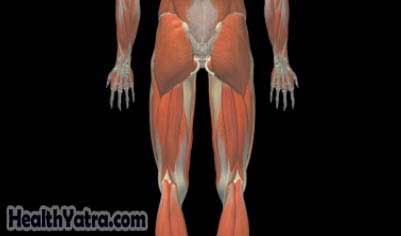Definition
A hamstring strain is an injury to the muscles in the back of the thigh. These muscles run from above the hip to the knee joint. A strain is a series of small tears in the muscle. The tendon attached to the muscle may also have some damage.
Hamstring strain is a common sports-related injury. Treatment depends on the severity of the strain.

Causes
A hamstring strain can be caused by:
- Stretching the muscle too fast and/or too far.
- Suddenly putting stress on the muscles when they are not ready for the stress.
- Using the muscles too much in one day.
- A direct blow to the muscles.
Risk Factors
Factors that may increase your chance of getting hamstring strain include:
- Participation in sports that require bursts of speed. This includes track sports like running, hurdles, or long jump. Other sports include basketball, soccer, football, or rugby.
- Previous hamstring injury.
- Fatigue.
- Overexertion.
- Tight hamstrings.
Symptoms
Symptoms may include:
- Pain and tenderness in the back of the thigh.
- Stiffness in the hamstrings.
- Weakness in the hamstrings.
- Bruising on the back of the thigh, if blood vessels are broken.
- Popping or snapping sensation as the muscle tears.
Diagnosis
The doctor will ask you about your symptoms and medical history. A physical exam will be done.
Most hamstring strains can be diagnosed with a physical exam. Your doctor may want images of the area if severe damage is suspected. Images may be taken with x-ray or MRI.
Muscle strains are graded according to their severity:
- Grade 1—Some stretching with micro-tearing of muscle fibers.
- Grade 2—Partial tearing of muscle fibers.
- Grade 3—Complete tearing of muscle fibers. This may also be called a rupture or avulsion.
Treatment
Talk with your doctor about the best treatment plan for you. Recovery time ranges depending on the grade of your injury. Treatment steps may include:
Acute Care
Rest
Your muscle will need time to heal. Avoid activities that place extra stress on these muscles:
- Do not do activities that cause pain. This includes running, jumping, and weight lifting using the leg muscles.
- If normal walking hurts, shorten your stride.
- Do not play sports until your doctor has said it is safe to do so.
Cold
Apply an ice or a cold pack to the area for 15-20 minutes, four times a day, for several days after the injury. Do not apply the ice directly to your skin. Wrap the ice or cold pack in a towel.
Pain Relief Medications
To manage pain, your doctor may recommend:
- Over-the-counter medication, such as aspirin, ibuprofen, or acetaminophen
- Topical pain medication—creams or patches that are applied to the skin
- Prescription pain relievers
Compression
Compression can help prevent more swelling. Your doctor may recommend an elastic compression bandage around your thigh. Be careful not to wrap the bandage too tight.
Elevation
Elevation can also help keep swelling down. Keep your leg higher than your heart as much as possible for the first 24 hours or so. A couple of days of elevation might be recommended for severe strains.
Recovery Steps
Heat
Use heat only when you are returning to physical activity. Heat may then be used before stretching or getting ready to play sports to help loosen the muscle.
Stretching
When the acute pain is gone, start gentle stretching as recommended. Stay within pain limits. Hold each stretch for about 10 seconds and repeat six times. Stretch several times a day.
Strengthening
Begin strengthening exercises for your muscles as recommended.
If you are diagnosed with a hamstring strain, follow your doctor’s instructions.
Prevention
To reduce the chance that you will strain your hamstrings:
- Keep your hamstrings strong so they can absorb the energy of sudden physical stress.
- Learn the proper technique for exercise and sporting activities. This will decrease stress on all your muscles, including your hamstrings.
